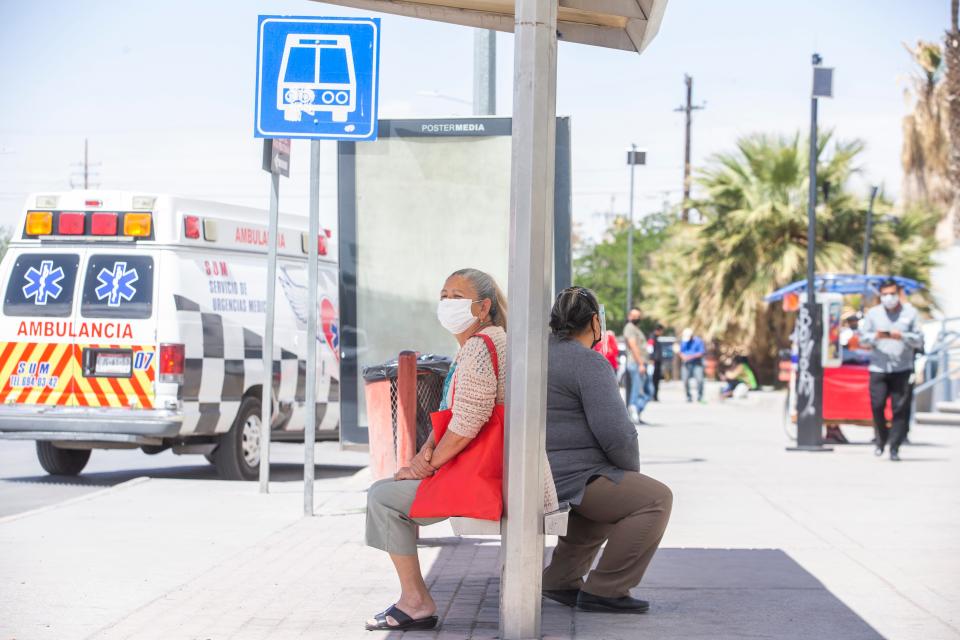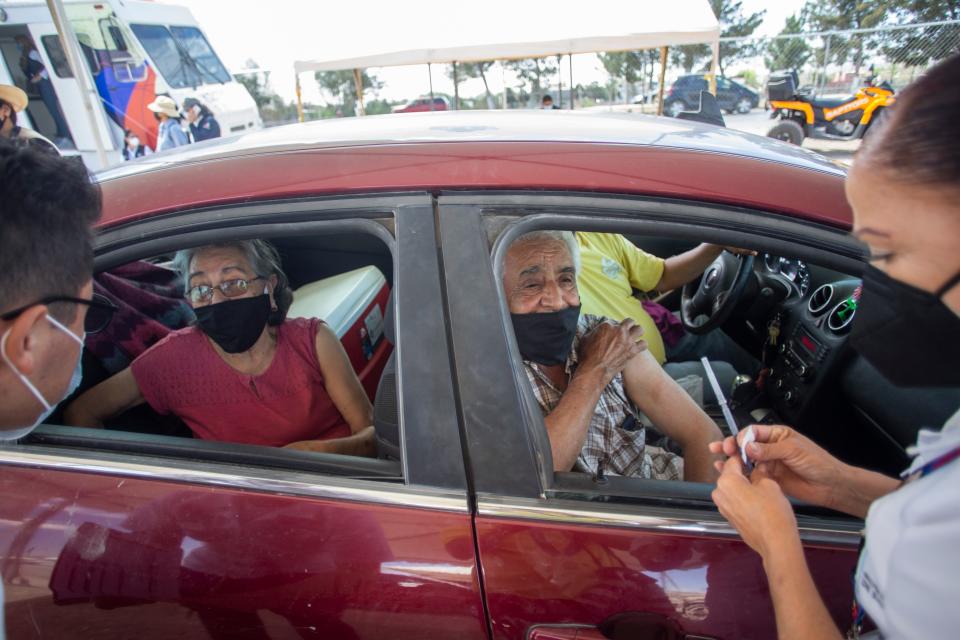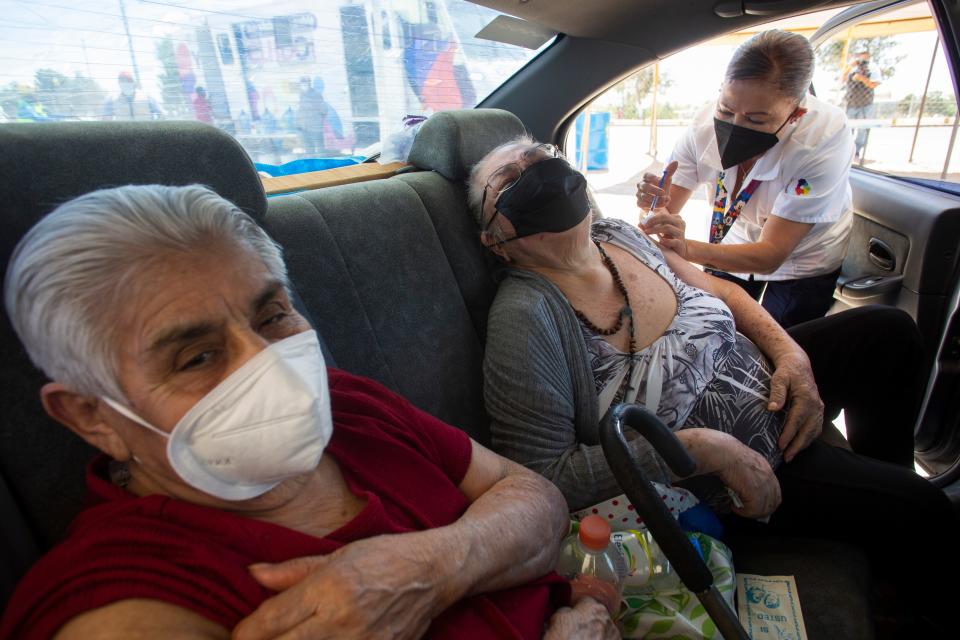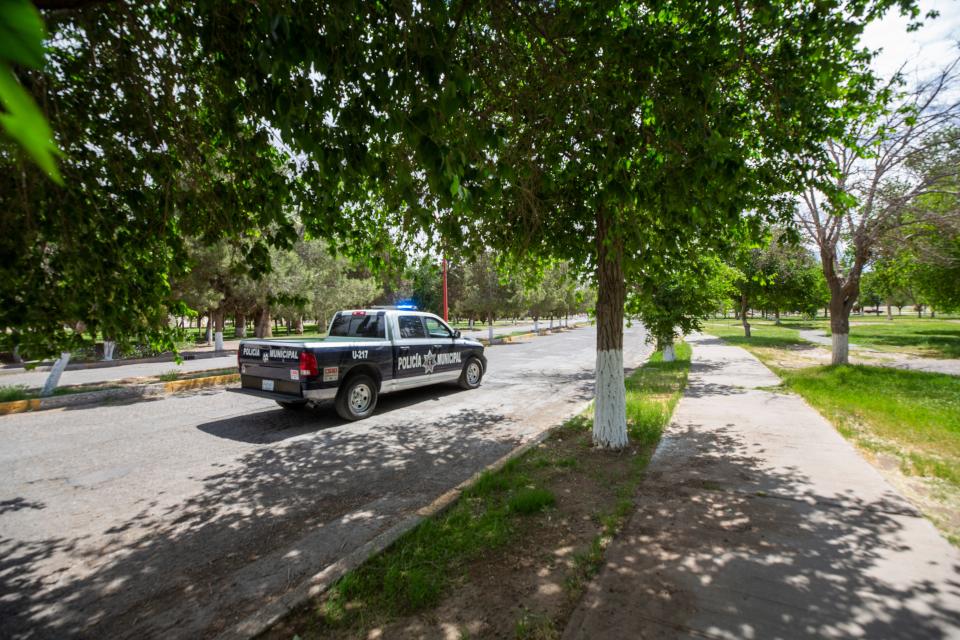Two cities, separated by US-Mexico border, are in completely different stages of pandemic
EL PASO, Texas – Army Maj. Carlos Gutierrez popped into an airport gift shop on his way to catch a flight for his second trip to California since getting vaccinated against COVID-19 – the surest sign for him that the pandemic is finally receding.
"I had stayed away from traveling because of the high risk. But with the vaccines, things are opening up," said Gutierrez, 43, traveling from El Paso to visit his grandmother, whom he hadn't seen since the pandemic began.
A few miles south in Mexico, Juárez residents prepared for the second weekend in a row for another "mega closure" May 1, when shopping malls, big box stores and restaurants shut down to slow a surge in coronavirus cases.
The global disparities in vaccine access and distribution are evident at the U.S.-Mexican border, where anyone who wants a shot can get one at Walmart or a pop-up clinic in El Paso, while doctors and nurses at private hospitals in Juárez fight for access to the vaccine.
Live COVID-19 updates: CDC announces new guidelines for mask use by fully vaccinated people; widespread shots for kids 12-15 begin
The disparate narratives create headaches for regional public health authorities, whose vaccine inventory in the USA depends on local, state and federal government distribution, and in Mexico is supplied by the Ministry of Defense and administered by state health departments.
"A little river separates us," said Dr. Manuel De La Rosa, vice president for outreach and community engagement at the Texas Tech Health Sciences Center in El Paso, who has served on cross-border health task forces. "We share the same disease, but we don’t have the same access to medications or to the vaccine. I think we’re not going to reach herd immunity in the region until we get the entire (Paso del Norte) valley vaccinated."

The principle applies globally: The longer the virus circulates, health experts said, the greater the likelihood that it will mutate and pose new risks to health.
"We’re concerned about variants developing," said Lara Anton, spokesperson for the Texas Department of Health and Human Services. "Right now the vaccines are very effective, but the longer the virus is circulating, the longer it has to mutate into a variant that the vaccine isn’t effective against."
Mexico has struggled to secure vaccines on the world market. Vaccine-sharing between the United States and Mexico – or between Texas and Mexican border states – has been minimal. The administration of President Andrés Manuel López Obrador relies on China and Russia to supply homegrown versions.

As of May 11, Mexico reported it had secured or was awaiting delivery of about 27 million vaccines, enough to vaccinate about 30% of the country's 93 million people over age 15. About 9 million people in Mexico are fully vaccinated.
El Paso County, which has a population of roughly 800,000, has applied more doses than the entire state of Chihuahua, which has a population of 3.7 million, has received: 713,031 versus 596,745. About 250,000 people have received at least one shot in Juárez, according to state health authorities.
In Juárez, the fourth wave of infections and second weekend of business closures weighed on residents and business owners tired of more than a year of periodic shutdowns, restrictions and elevated health risks.
Antony Shalhoub, 20, manages a family restaurant in Juárez with his mother and sister that depends heavily on weekend traffic. He said he didn’t think the pandemic would last as long as it has.
“I wish Mexico was taking the same measures that the United States is taking to get everyone vaccinated and that things could start to get reactivated,” he said. "It’s like, just when you think that all of this will be over, then suddenly there is another major closure. It hit us really hard.”
Tracking COVID-19 vaccine distribution by state: How many people have been vaccinated in the USA?
Mexico looks beyond its borders for COVID-19 vaccines
The daily count of new COVID-19 cases in El Paso has declined since early January, when El Paso County was reporting more than 800 infections a day. The new case count fell to 34 on May 10, a low in 2021.
El Paso health authorities said 66% of residents over age 16 have received at least one dose of COVID-19 vaccine, and 48% of the county population is fully vaccinated. Authorities shifted from fretting about vaccine availability to convincing hard-to-reach and hesitant populations to show up for a shot.

In Juárez, vaccine supplies can't come fast enough. Vaccines have trickled up from Mexico City on a slow drip; the next batch is scheduled to reach Chihuahua state at the end of May.
New cases of coronavirus spiked across Chihuahua during the last two weeks of April, prompting the state to order a near total shutdown of businesses on two consecutive weekends – a novel attempt to slow the spread without hurting economic activity Monday through Friday.
State health authorities reported 192 cases in Juárez in the week ending May 2, but that may understate the spread. Public coronavirus testing isn't widely available in Juárez; tests at a private hospital can cost 2,500 pesos, or $120, and are beyond most residents' reach.
The United States supplied 2.7 million doses of the AstraZeneca vaccine to Mexico this year – one of the brands not deployed in the USA. (China supplied Mexico with more than 8 million doses of two Chinese brands, CanSino and Sinovac.)
After speaking by video with Vice President Kamala Harris on May 7, López Obrador said the United States is willing to send more AstraZeneca doses to other countries after testing the supplies.
Mexican officials plan to ask the United States for more. Martha Delgado, undersecretary for multilateral affairs and human rights, told news agencies in late April that Mexico may propose prioritizing vaccination along its border with the USA.
There is no residency requirement to get vaccinated in Texas, but the restrictions on nonessential travel at ports of entry essentially prohibit Mexican nationals with a tourist visa from crossing to the USA, which means most Juárez residents can't cross to El Paso for a shot.
"We’re always concerned when you see cases on the rise anywhere, and we want to make sure that Texans know that getting vaccinated is the best way to protect themselves from the virus," Anton said.
‘Like having a newborn … but it never stops’: Facing motherhood's fiercest challenges, a California mom found hope
A year into pandemic, still no binational strategy
Elected officials in Texas said they recognize the imbalance and the risks posed to border communities.
Rep. Veronica Escobar, a Democrat from El Paso, has called for a coordinated, binational response to COVID-19 since early in the pandemic and has been frustrated by the Trump and Biden administrations' inaction on the issue of a cross-border strategy.

Despite numerous pleas to the White House – in phone calls with Anthony Fauci, chief medical adviser to the president, and letters to Jeffrey Zients, coronavirus response coordinator – a binational plan hasn't emerged. Escobar has written López Obrador directly and asked Congress to include a binational strategy in its COVID-19 relief packages.
"The federal government urgently needs to develop a coordinated binational COVID-19 response with Mexico," Escobar wrote April 22 in a follow-up letter to Zients, "one that ensures that any vaccines provided to Mexico are first used in their northern border communities tied to us through land ports of entry."
She told The El Paso Times, part of the USA TODAY Network, "I was delighted that President Biden sent vaccines to Mexico, but there was no requirement to use those vaccines in places that were advantageous to us."
Previously: About a third of Mexicans show exposure to coronavirus
U.S. Sens. John Cornyn and Ted Cruz, both Republicans, said they support the eventual sharing of vaccines with countries that need them.
“Sen. Cruz wants to ensure America is at full capacity to administer vaccines stateside and if there is any excess manufacturing capacity then begin administering to other countries," a Cruz spokesperson said in an emailed statement.
A spokesperson for Cornyn supplied a letter sent to Biden in which the senator asked the administration to support India and other hard-hit nations by providing medical supplies and surplus vaccinations. The letter didn't mention Mexico.
The United States and Mexico belong to a global effort to create equity in vaccine distribution.
COVAX, a consortium of 190 nations formed to combat inequalities in vaccine distribution, aims to purchase mass amounts of vaccines and equitably distribute them to countries to vaccinate at least 20% of their populations, especially health care workers and vulnerable groups.
World Health Organization Director-General Tedros Adhanom Ghebreyesus warned in January that nations "face the real danger that even as vaccines bring hope to some, they become another brick in the wall of inequality between the world’s haves and have-nots."
Coronavirus Watch newsletter: Sign up for daily updates right in your inbox
Dividing line between hope and frustration
At the El Paso airport, travelers in face masks bustled between check-in counters and milled about the baggage claim.
Herjid Kaur, 64, held onto her 3-year-old granddaughter's stroller with her 7-year-old granddaughter at her side. She is vaccinated; so is her daughter-in-law. The family was headed for Chicago to see her son, and she was "very excited," she said.
"It's the first time I have seen him in a year and a half," she said.
In Juárez, residents coming off a weekend of business closures flocked to grocery stores.
Jenny Alvarez, 24, and Hugo Benavides, 37, loaded their car with plastic bags in the parking lot of a Smart supermarket on Monday evening, the day businesses reopened.
Benavides said most of his family lives in El Paso. Watching them post photos on Facebook getting their second shot has been frustrating, he said. He thinks his COVID-19 vaccination could still be a year away.
“It's sad to see that they don’t see the magnitude of what we’re struggling with," he said.
Veronica Martinez is a Juárez-based journalist for La Verdad online newspaper.
Follow reporters Lauren Villagran and Veronica Martinez on Twitter: @laurenvillagran; @vamartinez10
Explained in four charts: Colonial Pipeline reopens pipeline amid surge in gas shortages, higher gas prices and panic buying
When will gas return? Is it safe to take a road trip? Your questions about gas shortage answered
This article originally appeared on El Paso Times: El Paso, Texas vs. Juárez: Global COVID vaccine disparity on display

 money
money 